Ecommerce conversion rate is a crucial metric for any online store owner who wants to expand their business and gain more profit.
You can use its data to learn what you’re doing right or wrong when it comes to promoting your products or services. By doing so, you can further improve your business strategies and work on turning more visitors into customers.
But—
How do you determine an optimal conversion rate for your store in the first place? And what are the ways to improve it?
Read on to learn all about it.
Learn how to boost your conversion rates and sales using AI
First things first—
What is an ecommerce conversion rate?
Simply put, an ecommerce conversion rate (or CVR) is a ratio between the total number of users who end up converting (i.e. making a purchase) and the visitors you have on your site within a specific timeframe.
It’s important to note that there are a few different types of ecommerce site conversions. These include:
- Adding the product to the cart—tracking this metric can help you determine which products are getting noticed the most among users
- Searching the website—this could be considered a micro conversion as it can lead to a customer completing the purchase
- Email sign-ups/subscribing to newsletters—these email marketing conversions help you establish and maintain client relationships
- Completed checkout—this is the moment a customer completes their purchase
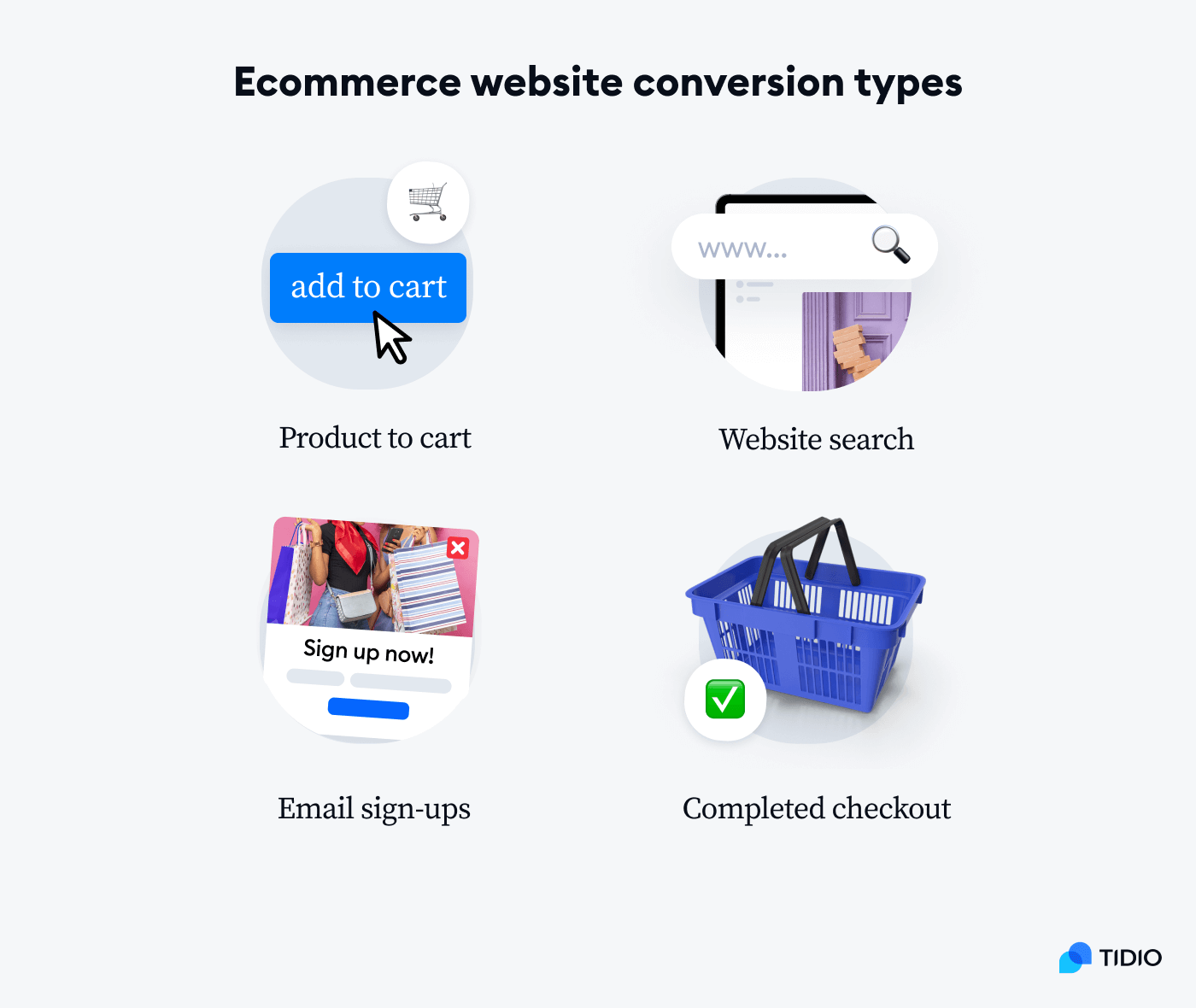
Keeping track of all these key performance indicators (KPIs) is important as it can contribute to the growth and success of your ecommerce business.
That being said, we’ll focus on the completed checkout KPI, as the ultimate goal of every online store is to make more sales.
Read more: Discover some of the best ways to increase online sales of your digital store.
Now, you must be wondering—
How do you calculate the ecommerce conversion rate?
Let’s say that 10 out of 1000 visitors ended up buying a product on your ecommerce website. To properly calculate your ecommerce conversion rate, you simply have to divide the total number of website users who took a desired action, or completed checkout by the total number of visitors. Then, multiply this number by 100.
So, for our example, the conversion rate would be 1%.
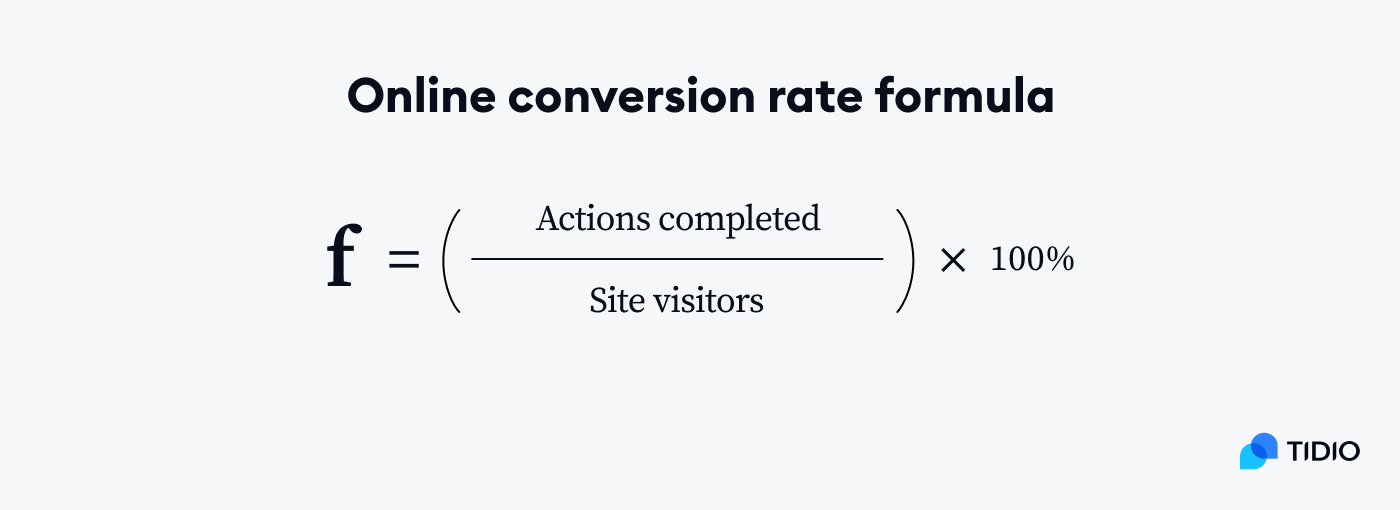
Now—
Knowing your current ecommerce conversion rate benchmarks is important so that you can compare them against the standard in your particular field. Then, you can work on a strategy to improve it. These KPIs can also help you figure out where customers are having difficulties (if any) and what prevents them from completing a purchase in the first place.
But wait—
What’s a good conversion rate for ecommerce?
Average ecommerce conversion rates across all industries fall somewhere between 2 and 3%. Say that you have about 12,000 monthly visits and your average rate is around 3%. This would mean that you had 400 people that made a purchase within that period.
Not bad at all, right?
So, generally speaking, anything over 3% would be considered a good ecommerce conversion rate.
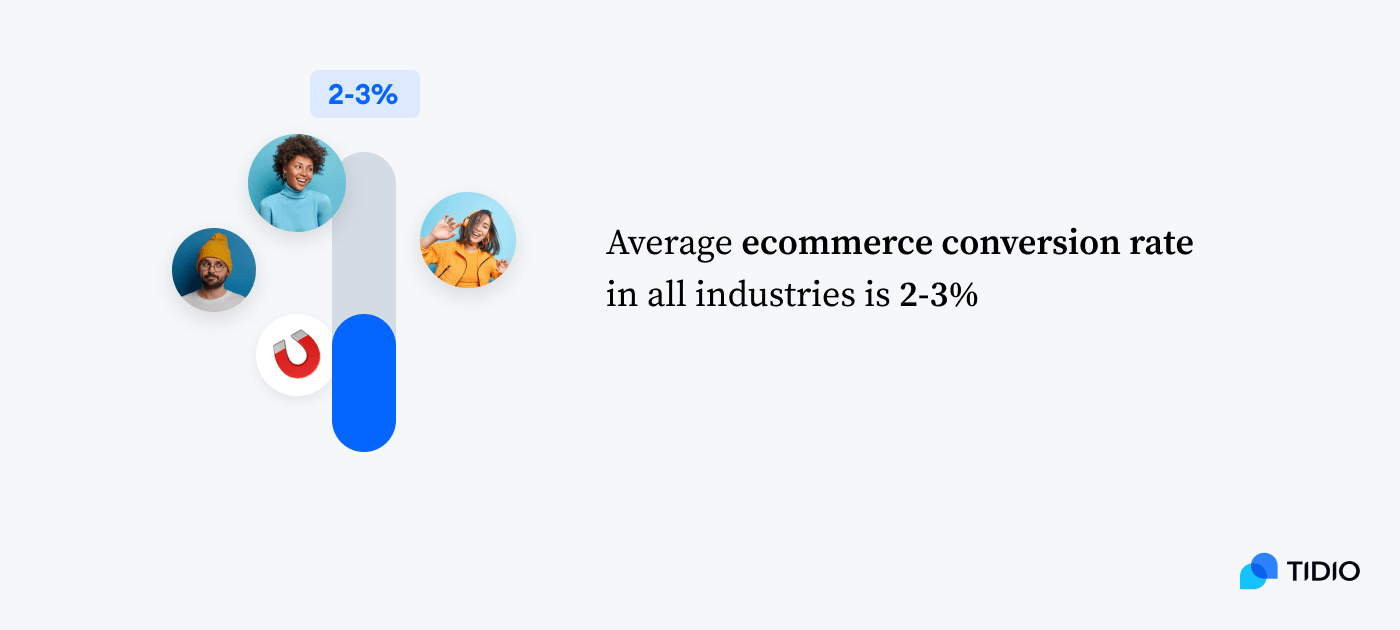
That being said, you shouldn’t strictly compare your ecommerce conversion rate to overall industry benchmarks.
The fact of the matter is that the data related to this metric can differ depending on the specific sector. So, you should aim to keep track of conversion rates in your own field and then use that as your benchmark instead.
Which brings us to the part you came here for—
Ecommerce conversion rate: benchmarks by categories
In the second quarter of 2022, the average ecommerce conversion rate in the US stood close to the industry average—around 2%. Still, these benchmarks can vary depending on the device used to make a conversion, the region, and the sector in question.
Let’s take a closer look at the average ecommerce conversion rates for all of these categories—and then some.
Average conversion rate by industry sectors
You wouldn’t compare the average order value of the company in the food & beverage sector to an online store selling luxury handbags, would you? And the same goes for the average conversion rate between different sectors.
So, let’s examine how the numbers vary across industries in Q4, 2022:

According to these statistics, the food ecommerce conversion rate, as well as one in the beverage sector is the highest across different industries, at well over 4%. Beauty and skincare take second place alongside the health industry with a slightly lower conversion rate (above 3%).
On the other hand, sectors such as electronics and home appliances were among the lowest on the list, with an average online conversion rate below 2%. It’s also worth noting that the home furniture ecommerce conversion rate had the lowest percentages, falling somewhere between 0% and 1%.
Finally, the average conversion rate for ecommerce across all sectors is exactly between 2-3%, which coincides with the above-mentioned report made by Kibo.
Read more: Learn all about ecommerce automation so you can fully focus on growing your business.
Now that you’re aware of the key conversion rate stats across the leading sectors, let’s see what the situation is like worldwide.
Average online conversion rate by region
The best way to tell how much the conversion rate in the ecommerce industry can vary is to simply take a look at the international picture.
Also, if your business operates locally, knowing your local conversion rate is especially important. Then, you will be able to figure out whether the number of conversions you receive on average is optimal for you or if it needs further improvements.
So, here’s the overview of online conversion rates in different regions of the world:

In the last quarter of 2022, conversion rates in Great Britain were the highest (at 4%), while in the US, this number only reached 2%. The EMEA region witnessed an average rate of over 1%, which is a similar number for ecommerce conversion rates in all other regions that aren’t mentioned in the graphic.
So, it’s easy to spot the trend of British ecommerce sites receiving higher conversion rates compared to the United States and other territories across the globe.
By device
Now, when it comes to different devices, the average conversion rate is overall higher for desktop than mobile users, although it’s been leveling with the other devices in the last few years.
As for the US shoppers, the online conversion rate stands at around 3% for both desktops and tablets, with mobile phones accounting for 2% of conversions.
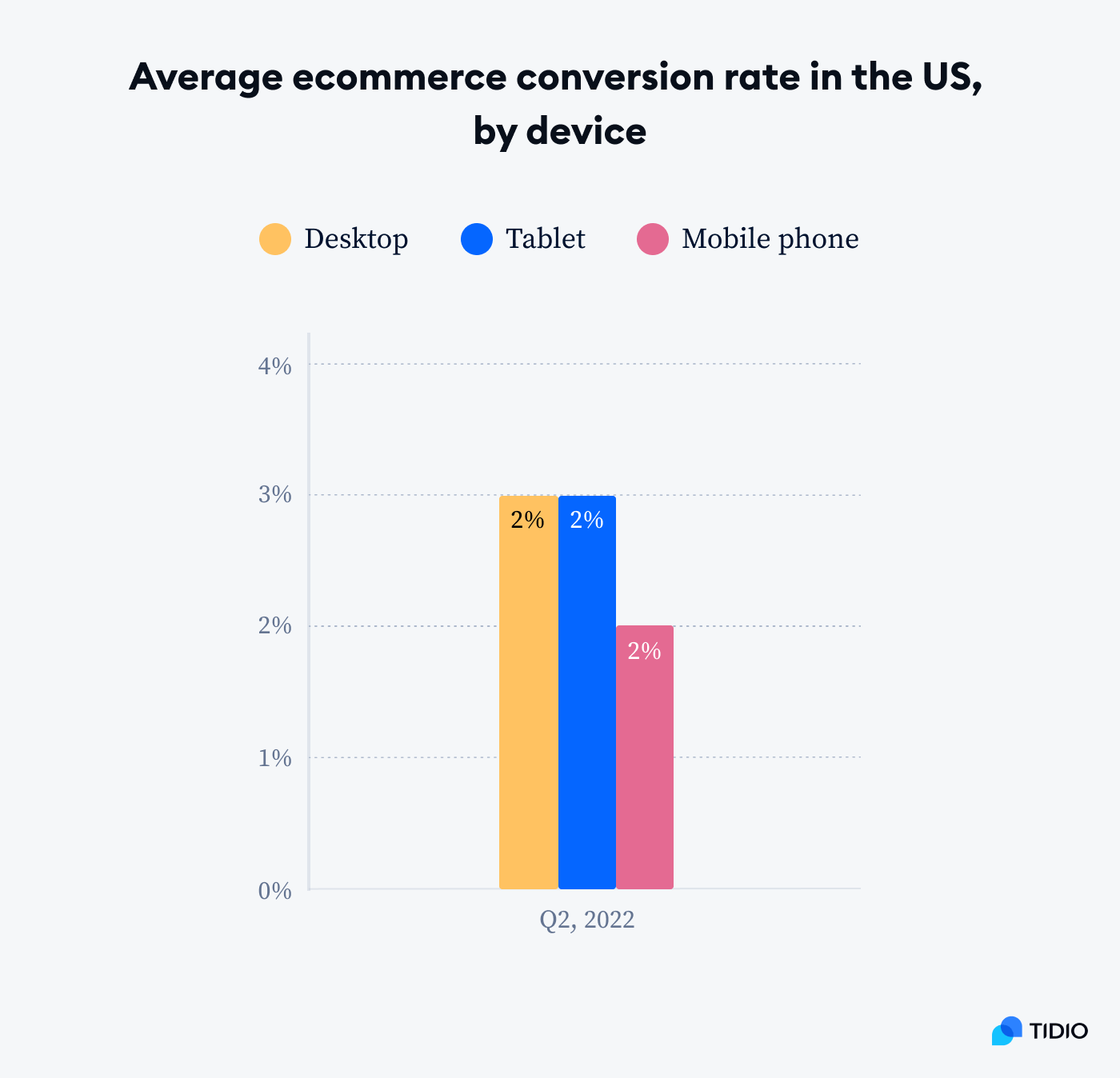
A similar situation can be found globally, with all regions that were part of the same study having the highest conversion rates on desktops, followed by tablets and smartphones, respectively.

Looking at these statistics, it’s safe to conclude that traditional online shopping via PC remains victorious over increasingly popular mobile commerce.
With all that said, more and more consumers choose to browse products through apps on their mobile devices. That’s why it’s crucial to remember to optimize your mobile ecommerce conversion rate as well. After all, this can only help boost your conversions with time.
Learn how to drive your website’s conversion rate through the roof using AI
By platform
Average online conversion rates differ not only by devices and industries—their data varies when it comes to different operating systems and search engine browsers, too.
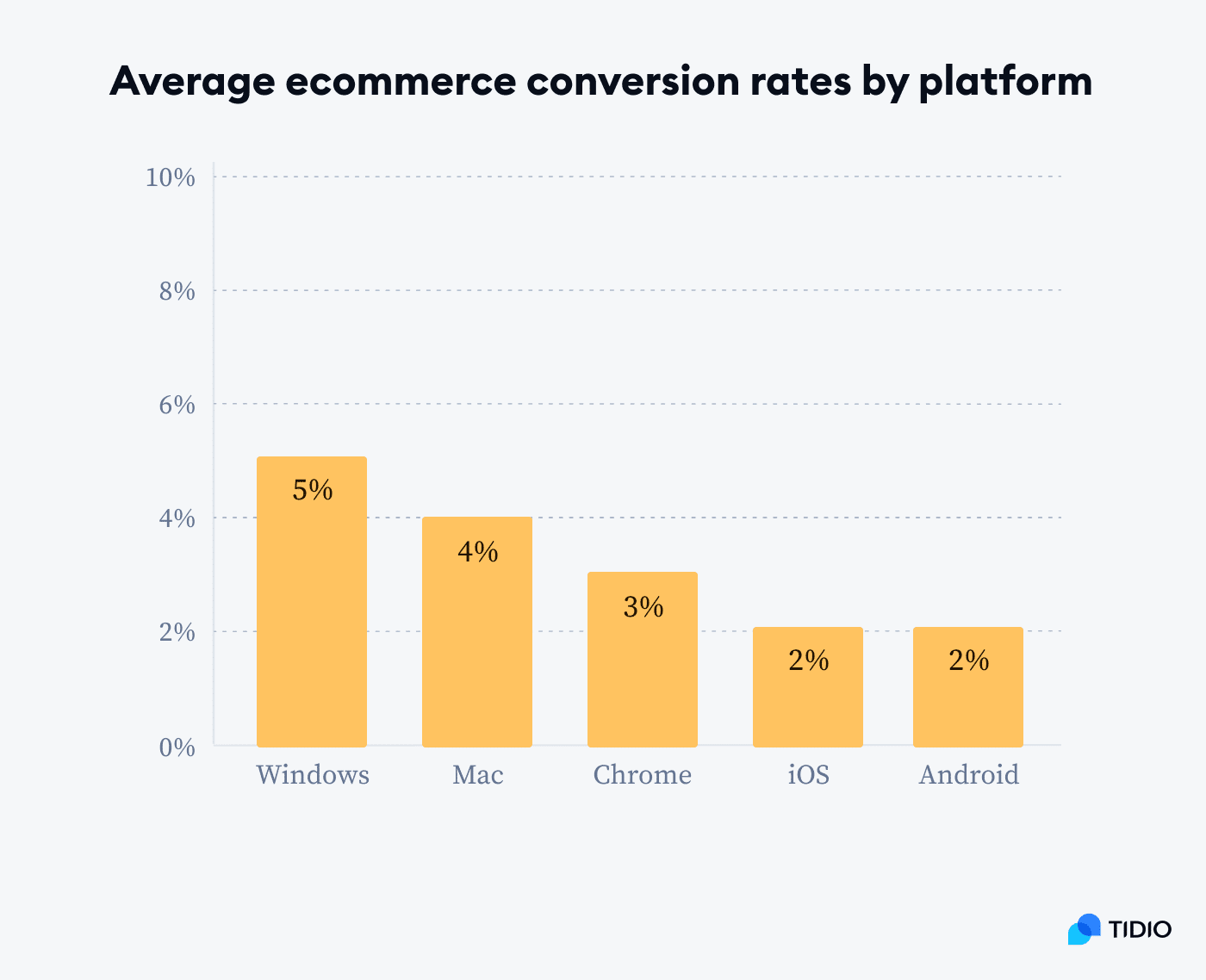
Unsurprisingly, Windows was the platform with the highest number of conversions—its average rate stood at a whopping 5%.
When it comes to other platforms, about 4% of site visitors were converted into purchases using Mac, followed by Chrome (3%), iOS (2%), and Android (2%).
Last but not least, Windows Phone and Linux had the lowest rates (barely above 0% for both).
Tips on how to improve your ecommerce conversion rate
Okay—
Now you’re familiar with some of the essential ecommerce conversion rate statistics. These will help you determine whether your efforts match those of your competitors.
But how to get your store’s conversion rates to meet and exceed the industry’s benchmarks?
After all, staying ahead of your competitors in ecommerce conversion rates equals more sales for you, and every online business out there wants just that.
So, without further ado, here are some of the most effective strategies you can use to boost the customer experience on your website and, in turn, increase your conversions.
1. Use clearer product images

When buying items online, people want to see all the details to check whether the product they’re eyeing is worth the purchase. So, naturally, seeing blurry images of a product or category page would be a major turn-off for anyone.
To increase the conversion rate of your ecommerce store, you should make sure to add multiple, high-quality product images that depict an item from multiple angles. Also, you should incorporate a zoom feature on each of the photos. This way, your website visitors can examine them in full detail and have a great in-store experience on your site. And this can only help you push the potential client to conversion.
Read more: Explore effective ways to build a solid product marketing strategy, learn the differences between a product and a regular marketing campaign, and what role it plays in the product life cycle.
2. Incorporate live chat into your site
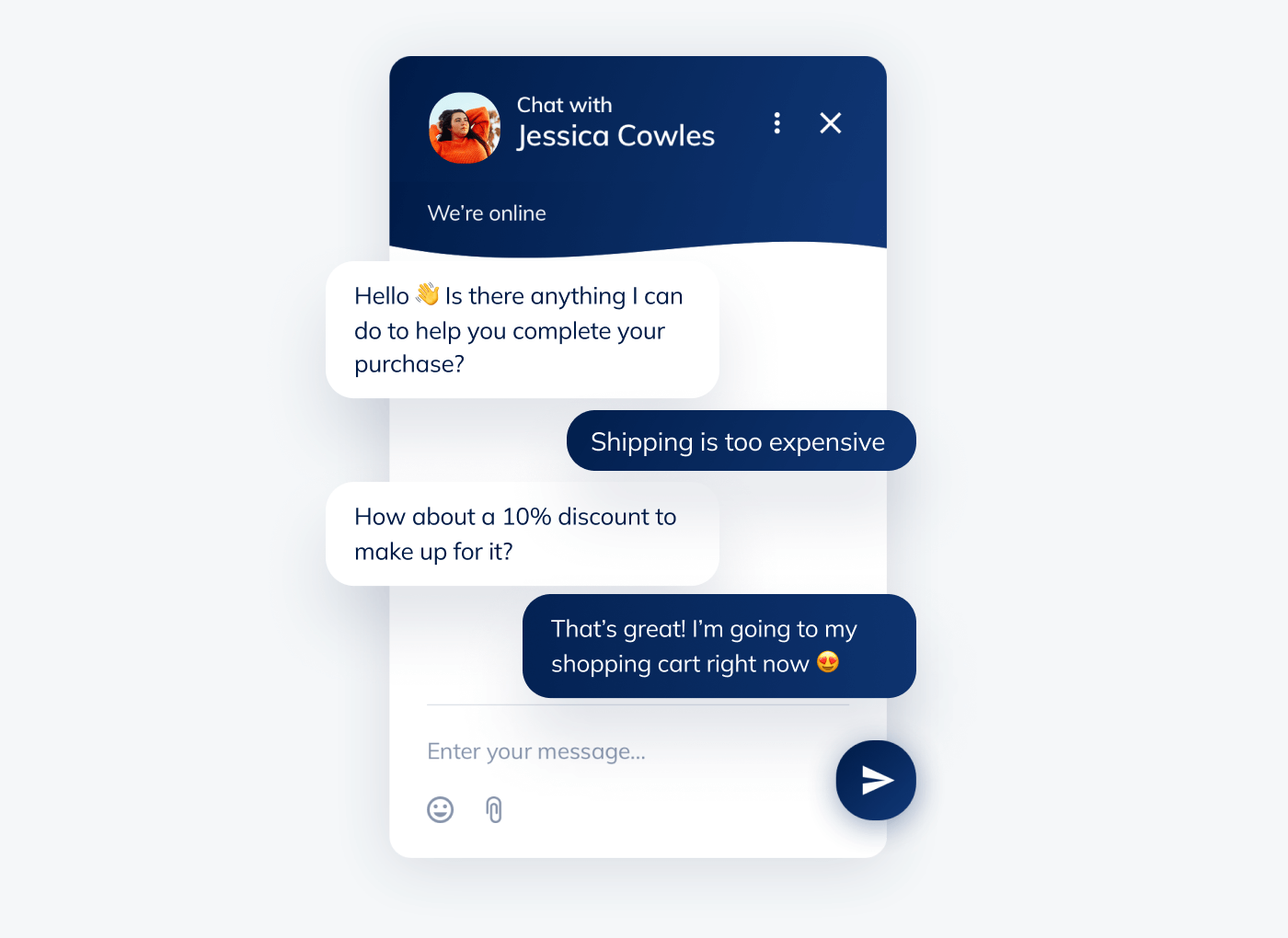
According to statistics, a whopping 79% of businesses report that live chat has had a positive effect on their sales and revenue. Moreover, about 38% of customers are more likely to buy from a business that offers live chat support. These numbers alone indicate just how influential adding live chat on your website can be for your conversions.
A chat widget can be useful during times when a customer wants to ask a more specific question that can’t be found on your product page, product categories, landing page, and so on.
Some live chat software also come packed with powerful automatization options. For example, you can use canned responses to provide quick answers to the most recurring questions.
Oftentimes, you can also add a chatbot functionality to your live chat widget. There are multiple chatbot templates out there—like a cart booster, FAQ chatbot, and others—that can help automate your customer journey, increase sales, and help visitors when you’re offline.
In short, live chat can be a powerful ally in assisting customers that require an instant, direct, and more specific approach. Plus, on top of helping boost your conversion rates, it can also enhance your customer loyalty and retention.
Read more: Check out how eye-oo, a multibrand ecommerce store, increased their revenue with the help of AI-powered customer service.
3. Use social proof and implement customer reviews

Surveys indicate that a whopping 95% of consumers look for customer reviews before buying a product. Therefore, it’s easy to see just how much social proof can influence a visitor’s decision to convert.
Applying this strategy is quite simple—allow your shoppers to leave reviews of your products on the dedicated product pages. Then, make sure to have the best ratings listed at the very top of your page so they can be easily seen. And don’t forget to perform some much-needed A/B testing before deciding on the best design.
You can use a ratings and reviews solution like Judge.me to make feedback collection easier. This platform’s widget is simple to install and customize so that it fits your brand’s design. On top of that, it allows you to automate your review requests using web, email, and SMS messaging. Moreover, you can share the best reviews on social media to drive more traffic to your store.
Read more: Learn all about the importance of customer feedback and find the best strategies you can use for managing it. In addition, be sure to check out how to easily collect customer feedback using Tidio.
4. Allow free shipping

Say that your item costs $15. Your customer deems the price as reasonable, only to arrive at the checkout and see that the price has doubled.
This usually happens because of additional fees such as tax and shipping. But, not being fully honest about the total costs from the get-go isn’t fair nor respectful to your potential customers and can easily put them off their purchase.
So instead, make sure to be transparent right away and display the total product price before a customer adds the item to the cart. Top it all off with a free shipping sign, and you will surely witness a boost in your conversions with time.
Read more: Find out how to build strong customer relationships and make your sales skyrocket.
5. Provide a guest checkout

One of the best ways to improve the experience of your customers is to free them from having to take any unnecessary steps to complete their purchase.
While some shoppers who visit your website for the first time may want to create an account to buy an item, the truth is, many of them only plan to make a one-time purchase. So, they don’t want to go into the hassle of creating an account because of one product.
In such cases, providing the option of a guest checkout for these visitors might be the best option for your business. By doing that, you will not only improve their overall user experience, but also significantly reduce shopping cart abandonment and increase conversions in the long run.
Read more: Explore the best ways to enhance your customer experience strategy and turn new shoppers into loyal clients.
6. Keep things simple
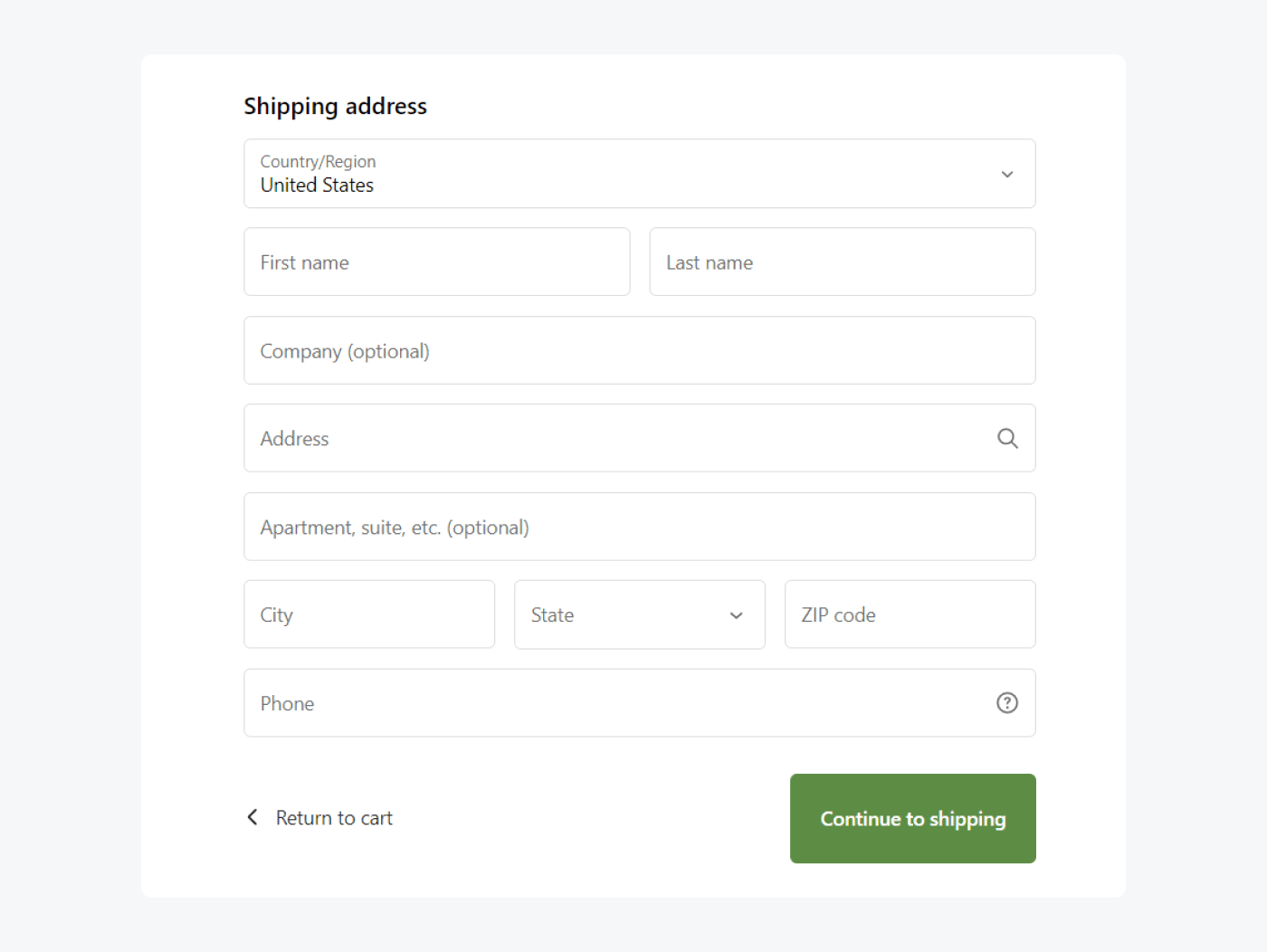
Users looking to buy products online all want the same thing—they want a checkout process that is quick, straightforward, and above all, user-friendly.
You can easily make this happen by adjusting the look and functionality of your checkout page so that it’s as minimalistic as it can get. This means that if there’s no need for adding extra fields, it’s best not to include them at all. So, stick to the basics, like asking for a shipping address and allowing them to choose their preferred payment method, i.e. debit/credit card, pass-through wallets, etc.
In addition, you should consider adding a progress bar to your checkout. Being aware of how many steps online shoppers need to take until the process is complete can reassure those who are in a rush and can even motivate them to complete their purchase.
Ecommerce conversion rate: key takeaway
And there you have it—now you’re aware of all the essential ecommerce conversion rate information and stats. There’s data here that covers everything from average rates across specific regions and devices all the way to worldwide regions and internet platforms.
The key to showcasing these statistics was to get you informed about different trends and benchmarks across various ecommerce sectors.
The bottom line—by becoming aware of a typical ecommerce conversion rate in your field, you will know how your performance indicators compare to your competitors. As a result, you will be able to determine whether your user experience tactics need further improvement.
The best ecommerce conversion rate optimization (CRO) strategies include:
- Using clear images to present your products
- Installing live chat and chatbots on your ecommerce platform
- Adding ratings and reviews for that much-needed social proof
- Adding the option of free shipping
- Including a guest checkout option for visitors
- Keeping things simple and user-friendly, no matter what
Try applying these tips right away and engage in some split testing, and watch as your conversion rates skyrocket!
Sources:
- Resources | Kibo Commerce
- Top Salesforce Research & Reports
- U.S. online shopping device conversion rate | Statista
- Global online shopping: device conversion rate | Statista
- Online shopping conversion rate by region | Statista
- Global conversion rate by industry | Statista
- U.S. online shopping conversion rate | Statista
- The Average Website Conversion Rate by Industry | Invesp
- Brand Rated: “Nine out of ten customers read reviews before buying a product”
- Live Chat Statistics — Kayako

